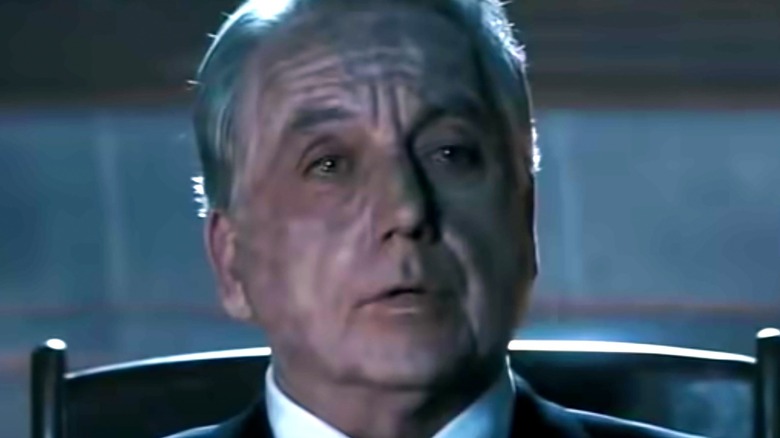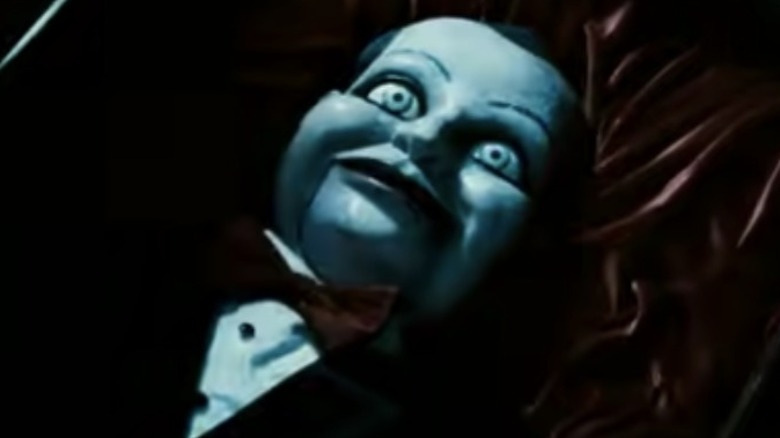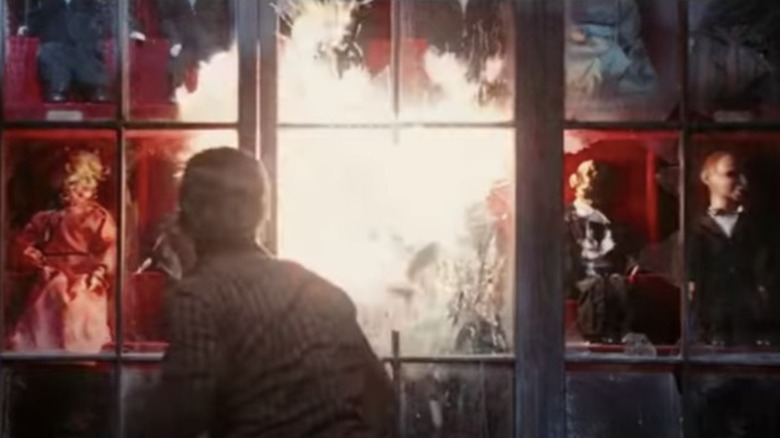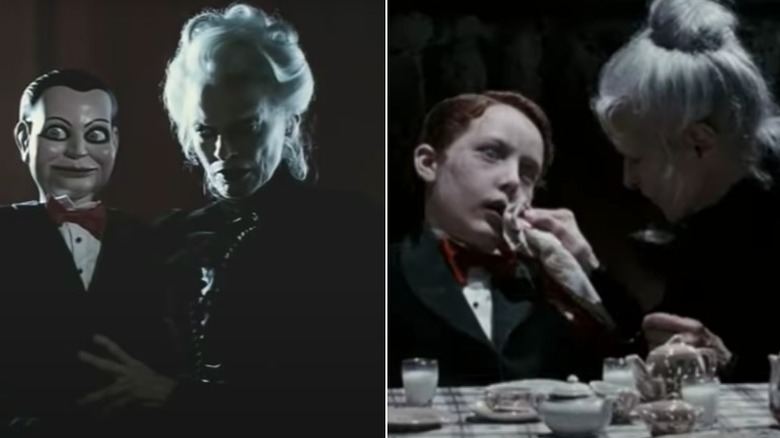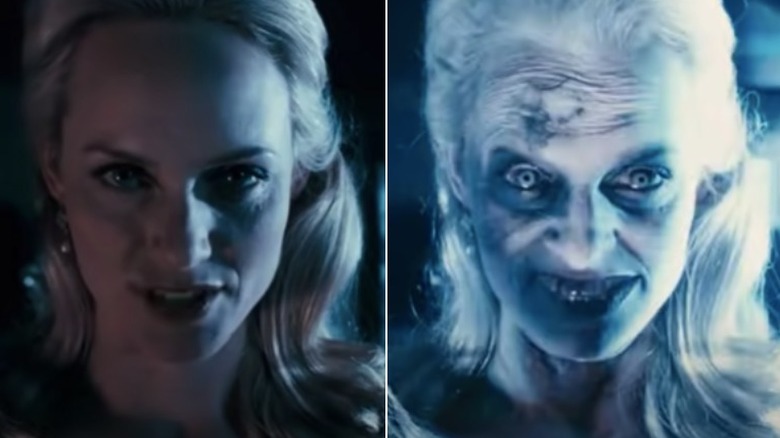The Ending Of Dead Silence Explained
Three years after director James Wan's "Saw" shook audiences to their core and birthed what would become a successful horror franchise, the "Insidious" director and co-writer Leigh Whannell released 2007's "Dead Silence." Despite starring relatively big names such as Donnie Wahlberg, Ryan Kwanten, Bob Gunton, and Amber Valletta, the film failed to garner much critical acclaim (via Rotten Tomatoes), but its relatively straightforward premise belies the same layered approach to the genre for which Wan would later become known and celebrated.
On the surface, "Dead Silence" is your typical haunted doll movie. Shortly after a creepy, antique dummy named Billy shows up unannounced on the doorstep of happy couple Jamie (Kwanten) and his pregnant wife Lisa (Lauren Regan), the latter is killed under suspicious and gruesome circumstances. Unsurprisingly, Jamie becomes the main suspect in his wife's death, and Wahlberg's Detective Lipton is determined to bring the confused and grieving lovebird to justice. After inspecting the dummy more carefully, Jamie discovers it once belonged to a long-deceased, early 20th-century ventriloquist from his hometown of Raven's Fair named Mary Shaw (Judith Roberts). In an effort to solve his wife's murder, Jamie returns to the town — and to his long-estranged father and young stepmother.
Though the majority of Wan's film plays out fairly predictably, his surprise ending accomplishes several feats at once: it simultaneously pays homage to the origins of his subject matter, puts a fresh twist on an old, old story, and plays on two of our worst fears — that of our own mortality, and that of the "uncanny valley."
Dead Silence is an exercise in horror homage
Developed in 1970 by robotics engineer Masahiro Mori, the "uncanny valley" describes the unnerving landscape that certain kinds of human-like objects occupy. Mori theorized that the closer a non-human but human-like entity (such as a robot or dummy) came to look like a human, the more uneasy it made people (via The Cut). Automatonophobia (the fear of human-seeming objects such as automatons) and its more specific subcategories, coulrophobia (the fear of clowns) and pediophobia (the fear of dolls), exist within this lurid landscape. Though the latter may seem like a recent invention of Hollywood, as Smithsonian's Linda Rodriguez McRobbie reveals, it's actually the result of 19th- and 20th-century developments in technology making both dolls and automata more realistic.
The ventriloquist dummy, as we know it and as "Dead Silence" depicts it, first entered the public sphere in the middle of this 19th-century automata "tech boom," and was further popularized in the 1930s by comedian Edgar Bergen (via Wonderopolis). In Wan and Whannell's film, Billy's story begins in the '30s, and pays homage to both the doll's historical significance and one of the earliest examples of pediophobia-based horror: writer E.T.A. Hoffmann's "The Sandman." First published in 1816, Hoffmann's story involves a malevolent alchemist/doll maker, and a man driven mad by his (uncanny) affection for the evil creator's lifeless creation (via Freud Museum London). And much like others of its time, "The Sandman" focuses more on the doll's creator than the object.
Unlike so many other sinister doll stories (e.g. "The Twilight Zone" episode "Living Doll"), "Dead Silence" remains true to the genre's Dr. Frankenstein-focused (as opposed to The Monster-focused) roots.
Dead Silence's gunfire-filled climax isn't an accident
In the penultimate scenes of the film, both Jamie and Detective Lipton realize not only that Billy is capable of much more than his inanimate existence would suggest, but that the woman who created Billy, Mary Shaw, is behind the doll's ongoing murder spree. The revelation begins when local mortuary owner Henry Walker (Michael Fairman) explains that after Shaw was aggressively heckled by a young boy in her audience who claimed he could see her lips moving, the boy disappeared, and the townspeople and family (who correctly assumed Shaw was responsible) turned on the old woman and lynched her. Per her request, Shaw was buried with her 101 dolls (whom she referred to as her children) and was "transformed" into a doll by the mortician.
Lipton and Jamie eventually find themselves surrounded by 100 of Shaw's dolls, all of which have been dug up and carefully installed in display cases in her old, run-down theater. In another director's hands, the spray of shotgun bullets and fire the duo rain down on the dolls (whom Shaw has been living through, Jamie notes) might come off as unintentionally comedic, but here, the modern action movie touch further reiterates the simultaneously vintage, yet timeless nature of pediophobia. One can't "kill" a socially ubiquitous fear of the uncanny valley any more than Jamie and Lipton can "kill" a possessed dummy (or 100 possessed dummies, for that matter). The scene also does a lot of narrative legwork for the film, in that it reveals what we're meant to believe is its final twist.
In Dead Silence, Wan gives us not one, but two twists
Via a "Saw"-esque clown doll, Jamie and Lipton hear the voice of Mary Shaw, who explains why she chose to kill Jamie's innocent wife. As it turns out, the young heckler Mary killed and turned into a doll prior to being executed was Jamie (Ashen's) Great Uncle. Since the Ashen family's lynching of Shaw involved prompting her to scream, then cutting out her tongue in order to silence her forever, her vengeance vow involved silencing all further members of the Ashen bloodline in the same manner. (Hence the film's repeated children's rhyme about Shaw: "if you see her in your dreams, be sure you never, ever scream.") While Shaw doesn't provide the entire backstory, she does explain to Jamie that she killed Lisa because she was carrying the last of the Ashens.
Here, the film winks at yet another early 20th-century exercise in pediophobia-based horror: Tod Browning's 1936 film, "The Devil Doll." Like Hoffmann's "The Sandman" before it, Browning's film pointed to the doll's maker as the true source of horror, this time working in a little good old-fashioned vengeance. In the film, Lionel Barrymore's Paul Lavond, like Mary Shaw, transforms real humans into murderous dolls and uses them to exact revenge on those responsible for his wrongful conviction. Unlike Lavond, Shaw is responsible for her crimes, but it's hard not to read into the characters' twin motivations. Rather than rely solely on horror homage, however, Wan and Whannell take the narrative one step further, adding a second twist in much the same way Wan does in "Malignant."
Wan's twist ending digs deep into our subconscious
When Jamie goes to his father's home on his quest to locate and destroy Billy, he finds him sitting there quietly — or rather, silently — in his wheelchair. This is when his beautiful young stepmother Ella (Valetta) provides the film's true revelation. Ella, he learns, is merely the "perfect doll" Shaw had been working on (and ultimately succeeded in creating) before her execution. His father Edward (Gunton) died long ago, and Shaw, through Ella's body, has been controlling him — in the exact same way a ventriloquist controls a dummy — in every instance Jamie (and the audience) has seen him. In a dazzling display of movie trope kitsch that rather overly recalls the ending of films like "The Usual Suspects" and "The Sixth Sense," Jamie begins to look back on all the clues he missed along the way that might have led him to this devastating truth much sooner.
With this final reveal, "Dead Silence" hints at something buried beneath our fear of human-like (but not quite human) entities. Perhaps, the film proposes, it isn't the lifeless face's resemblance to the living that so disturbs us, but its resemblance to the dead. Mary Shaw hasn't been working with dummies, but with corpses, and Jamie's (and our own) inability to distinguish between the two suggests that, on some level, we see them as one and the same. In the motionless, unblinking stare of the doll, the robot, the clown, or the dummy, we don't see something "life-like," but an unmoving, unflinching reminder of our own mortality.
